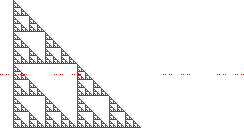| Typically, two lines, A and B, in the plane intersect in a point. Observe |
| dim(plane) = 2, dim(A) = 1, dim(B) = 1, and dim(A ∩ B) = 0 |
| so |
| dim(A ∩ B) = dim(A) + dim(B) - dim(plane) |
|
|
| Although the proof is quite complicated, the intersection result extends to fractal shapes: |
| if A and B are subsets of n-dimensional space, then |
| dim(A ∩ B) = dim(A) + dim(B) - n |
|
| |
| Example Suppose A is a gasket with dimension d(A) = log(3)/log(2) = 1.58496,
and B is a Cantor set with dimension d(B) = log(2)/log(3) = 0.63093. |
 |
| Certainly, some placements of the Cantor set will miss the gasket completely. However,
typically |
| d(A ∩ B) = 1.58496 + 0.63093 - 2 = 0.21589. |
| |
| Example Suppose A and B are Cantor sets in the (1-dimensional) line, and both dim(A) and dim(B)
are less than 1/2. |
| Then typically (that is, for almost all placements of A and B in the line), |
| dim(A ∩ B) = dim(A) + dim(B) - 1 |
| hence dim(A ∩ B) < 0. In other words, almost all placements of A and B are
disjoint. |
|

